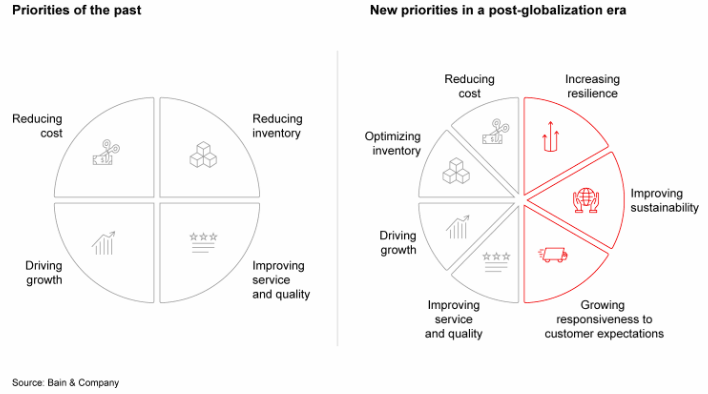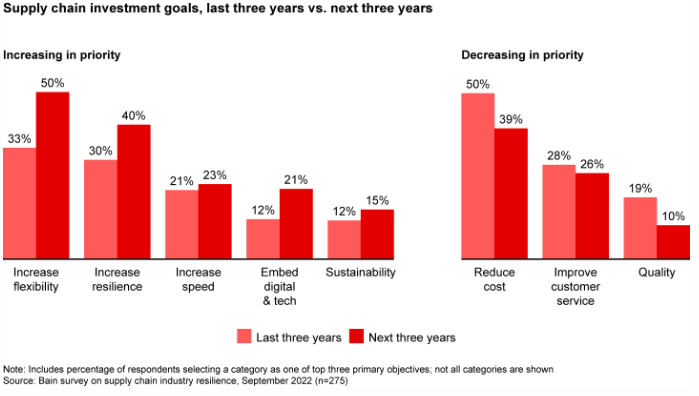Here at SCDigest, we used to do a lot of review and summary of reports and white papers from a wide variety of consulting firms.
Gilmore Says.... |
 |
| Bain says its recent review of nearly 400 of the largest US-based companies found that 60% had formal circularity commitments as of September 2023. |
 |
What do you say? |
|
| Click here to send us your comments |
| |
|
|
|
In more recent years, I backed off the practice, frankly because in my opinion the quality of the content and insight was drifting down, such that I was too often reviewing thought leadership pieces that bored me.
But I made a new year’s resolution of sorts to check out some of the latest or upcoming reports from the consulting community, and recently found a pretty decent effort from the consultants at Bain & Company that I think it worth summarizing.
The basic idea from Bain: the world has changed, and the types of trade-off decisions that have to be made in supply chain have more dimensions that even just a few years ago. This opens up both opportunities and threats.
The past four years of a pandemic and disruptions have changed the supply chain game, Bain says.
As a result, Bain says, for CEOs and CSCO, the question that must answered is no longer “Should we reinvent our supply chain?” but rather, “How should we reinvent our supply chain?”
Why? In large part, because the number of trade-offs that must be managed have grown in number and scope.
Bain also says that today there is more “turbulence” in supply chain than in the recent past, citing labor challenges, sustainability pressures, the potential impact of AI, and more.
It seems to me that various observers always call the present supply chain environment to be the most challenging, complex, etc., of all-time, so I would say let’s not get to hung up on the level of current turbulence versus the past.
But I am willing to agree that there are today somewhat more dimensions that have to be considered in decision-making, as illustrated in the graphic below:
Successful Supply Chains must now Balance Trade-offs
between a Larger, more Complex Set of Priorities

Source: Bain
Bain backs up that view with some survey data, which as shown below indicates priorities are indeed changing, both in the current time and looking ahead.
Shifting Supply Chain Priorities

Source: Bain
“The reality is that it simply won’t be feasible to make a supply chain 100% resilient, sustainable, responsive, and still cost effective,” Bain says, but adding this rub: “Making only incremental changes won’t be sufficient to compete”
Getting to the heart of the matter, Bain says that successful supply chains over the next few years will be marked by the following attributes:
More Built-in Flexibility: Bain notes that resilience is a must but also “is very expensive, requiring companies to develop capabilities in monitoring and recovery in addition to flexible design.”
I am not sure what that really means. Let’s move on.
More “Split-Shoring”: This refers to a balance between offshore manufacturing and manufacturing closer to customers and suppliers.
Bain notes that “The calculus on low-cost offshore manufacturing hubs has changed as a result of geopolitical instability and the desire to deliver products faster, more reliably, and with a lower carbon footprint.”
More Visibility into the Whole Chain: The quest for greater supply chain visibility is as old as the supply chain itself, but apparently, we’re not there yet.
Bains says that feeding near-real-time supply chain data “into advanced software models and artificial intelligence technologies will unlock huge benefits,” such as more easily spotting and responding to risks and disruptions, among many other possibilities.
More Circularity: While most of the focus is on reducing CO2, Bain says that “Leaders are making their supply chains less linear by implementing models that recycle, remanufacture, repair, and repurpose materials and equipment.”
I was a little dubious on this, but in the report Bain says its recent review of nearly 400 of the largest US-based companies found that 60% had formal circularity commitments as of September 2023.
All that until now was good enough. But I wasn’t wild about the report’s recommendations, which included some that seemed rather bland given what Bain says are the stakes.
That includes advice to take a holistic view to redesign the whole system, and to assign a cross-functional team to find end-to-end solutions - not exactly breakthrough thinking.
But I will agree we have more variables to consider today. As an obvious example, what used to be a two variable trade-off curve between inventory and shipping costs, is a now at least a three-variable trade-off cube or something, with the need to bring sustainability literally into the equation.
So there you have it. You can find the full Bain report here: How CEOs Can Balance the New Supply Chain Equation
What is your reaction to these thoughts on the Bain report? What would you add? Let us know your thought at the Feedback section below.
Your Comments/Feedback
|